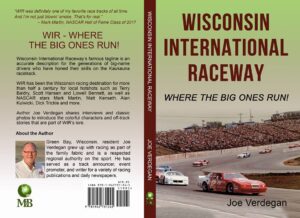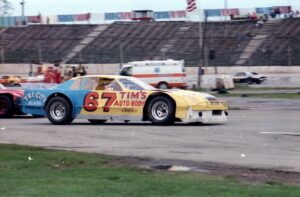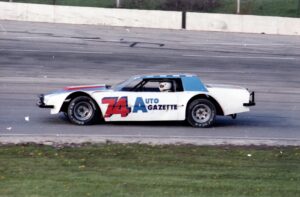The Vault
WIR’S 1/4 MILE SPORTSMAN CLASS WAS “DETROIT IRON”
Posted on: Wednesday November 2, 2022

(The following is a chapter titled “Detroit Iron” from the 2016 release “Wisconsin International Raceway – Where The Big Ones Run.” This book is for purchase at this website by clicking on the “books” tab.)

Darboy’s Dennis Dietzen was one of the frontrunners of the 1/4 mile sportsman class at Wisconsin International Raceway in Kaukauna, Wisconsin for decades. (Bob Bergeron photo)
The sportsman division at WIR in the 1970’s and early 1980’s could just as well been dubbed “Detroit Iron.”
For the most part the cars were tough – made of real, original sheet metal from the manufacturing plants in lower Michigan. The cars were real Chevrolet camaros, real Pontiac firebirds, real Ford mustangs, real Dodge darts. Unlike the cookie cutter-looking machines of the modern era, the sportsman class had true parity.
“It just seemed like everybody put all their own stuff together back then,” said Appleton’s Bill Fischer, who launched his racing career on the flat quarter-mile in 1983. “There was a lot of ingenuity back then and the cars were identifiable.”
One week Fischer got a call from Dan Devine, a car owner in Mackville. “His driver, Ross Goldbeck, was drilling wells in Minnesota so he couldn’t make it,” said Fischer. “Dan told me “we’re bringing Ross’ car to WIR and you’re going to race it. That’s how I got started. I brought my motorcycle helmet and used that and raced in a t shirt and shorts. We didn’t wear racing gloves or anything like that like they do now.”
Because the cars were very affordable the sportsman class was never lacking for car count. “There were times we’d have more than 50 cars,” recalled Fischer. “For a while it seemed like we’d have two semi-features.”
Fischer’s last season as a driver was 1997. He continues to help out on Thursday nights working as a pit steward.
Dave Van Elzen’s “Detroit Iron” was a blue 1972 Nova once built and driven for years by Kaukauna dirt late model legend Pete Parker. 1980 was Van Elzen’s year to shine, as he shattered the track record qualifying laps at not only WIR, but also local dirt tracks at Shawano and Luxemburg – all with that same old Nova. “We did real well in points that year, too,” said Van Elzen, a Kimberly native who now lives in Sherwood. “We won the championships at Shawano and Luxemburg and got either second or third at Kaukauna. And we stayed busy going three nights a week, with two of those nights being with the same car switching over from asphalt to dirt.”
Van Elzen got his start by pitting for Parker for a season and learning a lot. “Pete (Parker’s) pit crew that year was me, Ron Van Roy and Pete’s Dad Mel,” said Van Elzen. “Roger Van Roy had that Nova for a while and then Frank Van Oudenhoven drove it as a late model a couple of years later.”
Van Elzen was able to squeeze enough speed out of that Nova – especially on Thursday nights. “At Kaukauna I had fast time six out of the thirteen nights we ran,” said Van Elzen. “We were running so fast one time that summer that Mike Randerson came over and said “bring that car over to my shop I’d like to scale it sometime.”
The work to convert the car from asphalt to dirt would start at the track on Thursday nights. “As people would be drinking beer around our pit we’d be pulling the windshield out and replacing it with a screen for Shawano,” said Van Elzen. “We’d put the dirt tires on right at WIR that night too.” Then on Saturday nights at Shawano we’d have to switch transmissions to race at Luxemburg the following night. It kept us busy.”
One night at WIR Van Elzen tangled with Jim Duchow. “I remember that crash because Chuck Grall drove underneath my car when I was flying through the air,” said Van Elzen. “It was a bad wreck and when I went to work on Friday we were real busy and I didn’t think we’d be able to make it to Shawano Saturday with all the repairs we had to make.”
Van Elzen received a pleasant surprise when he returned home from work Friday. “My pit crew had gone out to Clyde Schumacher’s junkyard to get the parts we needed to get it fixed,” said Van Elzen. “We made it out to Shawano but just as time trials were getting wrapped up.
“We rolled through the gates and their race director Corny (Schmidt) told me “you’ve got five minutes to get this thing unloaded and get a qualifying lap in.” I see Mike Panure (one of Van Elzen’s top competitors at Shawano) leaning against the inner guardrail. I asked Mike “how’s it going?” He replied “I just set the track record with a 26 seconds flat lap.” We unloaded our beat up Nova from Thursday night, took a lap and broke his track record with a 25.9. Then I saw Panure climb back into his car and try to get his track record back but it didn’t happen.”
1980 turned out to be profitable for Van Elzen, as he actually made a little bit of money racing when all of the bills were paid at years end. “That was a fun year and at Kaukauna it seemed like I was starting in the back row every week,” said Van Elzen. “Guys like Chuck Grall always seemed to start in the front row week after week.”
It was in 1980 when the club began implementing a rule that the previous weeks feature winner needed to start in the back of feature starting lineup. That rule was put in part to help eliminate drivers from “sandbagging” or purposely qualifying at a slower speed to get a better starting spot for the features.
Van Elzen raced two more seasons after his big year and stepped away from racing in 1983 to build his home in Sherwood. His racing career on the quarter-mile resumed in 1989. He retired again in 2000 when the sportsman class moved to the half-mile. “I was against those cars moving to the half mile because it just cost too much money,” said Van Elzen. He’s continued to coach middle school football for the Sherwood Lions football club for nearly a quarter of a century. “I love working with kids.”
Darboy’s Dennis Dietzen was a champion on the quarter mile in 1976 and 1986 at WIR. Dietzen got his start racing in the Figure 8 class with Dave Valentyne. “I bought a Plymouth Coupe from Jerry Meyer in ’66,” said Dietzen. “Everything came out of the junkyard so racing was affordable then.”
The flat quarter-mile made it very tough for drivers to pass on. “Sometimes in a feature we’d have 14 cars and nobody moved,” said Dietzen. “Wherever you started that’s where you ended up. It was so close.”
Championship points were tough to get because of the limited passing. After time points were awarded for top qualifiers in time trials. “That was also done to help prevent sandbagging, too,” said Dietzen, who also as a Fox River Racing Club vice president four years and a treasurer for six years. “I got involved with helping to run the club just to help chip in. It seemed like we had a real good spirit of cooperation back then. It’s a little bit different now.”
Dietzen hung up his helmet after the 1987 season. “It was still somewhat affordable even when we got out of racing,” said Dietzen. “I remember we ran an entire season and only bought eight tires.”

Kurt Johnson’s race cars were always eye-catching and shiny. (Bob Bergeron photo)
Kurt Johnson, another sportsman competitor, got thrown right into the fire as a FRCC club president in just his second year of racing in 1980. “I got it handed off to me because nobody seemed to want to deal with the headaches at the time,” said Johnson, from Oshkosh. “But truthfully it did sort of run itself. They had guys lined up to work with Joe (Van Daalwyk) so it wasn’t really that bad. We basically dealt with and maintained the growth the club was experiencing.”
As for his own racing career Johnson got involved in racing through two other racers – Pete Weyenberg and John Geske. “Geske worked for my Dad and I bugged those guys in the shop, hanging around and being on their pit crews,” said Johnson.
Johnson’s first time behind the wheel was 1979 driving a Ford. “The first year I was in everybody’s way,” joked Johnson, whos career racing ended in 1984 when he won the track title. “All the tough guys were Pete Berken, Dennis Dietzen, Jim Duchow and Jeff Herrmann.”
Johnson was heading the FRRC ship when the 9:1 compression rule for late model motors was implemented across Wisconsin, including WIR. “Bob Abitz was the Vice President then and he sort of went and ran with it as he was our tech inspector,” said Johnson. “He had all the tools and that. He had gotten out of racing himself then.”
Johnson did his two year term. Al Gouelke, Ray DIetzen and Donny Hauser were the other board members he worked with.
Johnson’s last year racing was 1984 when he won the track championship. His biggest on track rivalry was with Berken. “We traded paint more than once,” quipped Johnson, who sported car number 74 because 1974 was the year Johnson graduated from high school.
Neenah’s Rick Spoo got his racing start in the sportsman class as a crew member for Johnson. “I went to the races when I was younger and I really enjoyed it,” said Spoo. “I helped build cars with Kurt (Johnson) and eventually I started my own racing career.” Spoo chose number 24 because that was his age when he started racing in the mid 1980’s.
Spoo quickly found success, winning the track titles in 1987, 1990 and 1991. “I remember Steve Smits being a real tough competitor to run with,” recalled Spoo. Spoo was voted Sportsman racer of the year after the 1990 season by the group Wisconsin Farns For Auto Racing. “That was a real big deal back then,” explained Spoo. “They’d have a real nice banquet they’d invite you to down in Milwaukee. It was real classy.”
After winning his ’91 quarter-mile crown, Spoo made the bold move up to the half-mile and the late model class. “It was a whole new creature,” explained Spoo. “I didn’t have the success that I had on the quarter mile. The biggest expense moving up is motor and tires. The tire rule just got out of hand. When I started out it was unlimited tires. There were guys running six tires a night. Guys would start up front and they’d put on brand new right sides for the tires. It was crazy.”
When drivers race late models on the half-mile most have a “keeping up with the Jones’” mentality and feel the need to buy big, fancy enclosed trailers – even if they only live minutes from the track. Not Spoo. “I was one of the few half mile guys towards to end who still towed my car there with an open trailer,” said Spoo. “The trailer doesn’t make you go any faster. I still have it to this day.”
Spoo packed away his drivers suit and retired after 2003. “They were switching the concept to an ACE motor. I did not see things going that way. I was short on sponsors and it was just time to get out.”
Kurt Johnson wasn’t the only sportsman driver loyal to Ford’s “Blue Oval.”
When the Gintner brothers Tom, Randy and Larry grew up in Neenah, their Dad Robert Gintner would prefer any other family or visitors to the house to park their Chevrolets or any other non-Ford vehicle in the road and not his driveway. “Dad wasn’t a racer himself but was always a diehard Ford guy,” said Tom Gintner. “So us three brothers always run nothing but Ford stuff our entire racing careers. Running Fords was engrained in us. There was not another option it seemed.”
“If it wasn’t for Dad, none of us would ever have taken up racing,” said Randy Gintner. “While he never raced he was always helping us on the pit crews and stuff.”
Tom and Randy started out racing on the dirt at Leo’s Speedway in Oshkosh – Tom in 1973 and Randy in 1977. “I remember they called a meeting for the rookies underneath the grandstand before the ’77 season and I’m sitting next to Alan Kulwicki of all people,” recalled Randy. “I had a ’64 Ford Galaxy and rolled it over that year. I ran it on the asphalt at WIR and I also ran it on the dirt half mile at Seymour too that was my one and only year on the dirt.”
Tom and Larry wheeled Ford Mustangs and Torinos throughout the years. The brothers always kept detailed records and receipts of what they were spending on their fast-paced hobby. “One year when I ran after all the bills were paid I wound up making a $25 profit,” said Larry Gintner. “I kept real close records of what I spent and what I made.”
Randy Gintner actually turned a profit racing the Ford Galaxy. “I paid $1,000 for it and that season I ran it I took in $1,800 in prize money,” boasted Gintner. “I got my moneys worth out of it. Every year I’d do stuff to update it. I’d take a car that ran 18 second laps and I got it down to a 15.5 lap time. My theory always was you should be building the car from scratch to save money. That’s what I did. I had a family to raise and house payments and stuff. I wasn’t going to go broke racing that’s for sure. My philosophy was you should build it from a boneyard versus a speed shop.”
In 2000 the sportsman class was moved up to the half mile. Randy’s tired old piece of iron just couldn’t compete on the bigger track with the newer, tricked out chassis. “It would have cost between 10 to 18 thousand dollars for us, on average to move up (to the half mile) so we decided against it,” said Randy Gintner. “The last year 2001 I ran at Columbus 151 Speedway.”
WIR SPORTSMAN DRIVERS LIST 1985
0 Jim Belling Larsen ’84 Firebird
03 Wally Blank Menasha ’83 Fairmont
04 Pete Berken Appleton ’85 Camaro
05 Dick Willing Appleton ’85 Thunderbird
07 Robin Boegh Menasha ’83 Mirada
1 Randy Boegh Appleton ’84 Firebird
2 Jim Duchow Kaukauna ’84 Camaro
3 Don Hauser Little Chute ’84 Thunderbird
4 Dan Meisenhelder Kaukauna ’81 Camaro
5 Rod Wheeler Appleton ’85 Firebird
6 Gary Stankevitz Green Bay ’78 Firebird
7 Ran Schmoeker Kaukauna ’82 Camaro
8 Mike Kasparek Tigerton ’70 Chevelle
V8 G.M. Cobb Menasha ’68 Camaro
9 Todd Herrmann Kaukauna ’81 Camaro
10 Mark Anthony Appleton ’81 Camaro
12 Russell Keberlein Kaukauna ’81 Camaro
14 Gene Steinfeldt Appleton ’72 Nova
15 Jerry Smits Appleton ’73 Mustang
16 Steve Henry Appleton ’82 AMC Spirit
17 Mick Hopensberger Menasha ’65 Chevelle
18 Jack Hardy Appleton ’81 Camaro
20 Gary Sieg Appleton ’85 Camaro
22 Mark Vandenboogard Little Chute ’83 Firebird
24 Rick Spoo Neenah ’85 Buick Regal
25 Krisanne Haufschildt Wrightstown ’79 Cutlass
26 Horse Haufschildt Wrightstown ’81 Grand Prix
27 Dwayne Maroszek Hortonville ’81 Camaro
30 Tommy Raatz Appleton ’81 Camaro
31 Russ Wagner Little Suamico ’84 Firebird
32 Gil Wagner Green Bay ’84 Camaro
33 Randy Rasmussen Little Chute ’84 Monte Carlo
34 Jerry Wenzel Two Rivers ’81 Camaro
40 Ross Goldbeck Appleton ’83 Cordoba
44 Bill Fischer Appleton ’85 Camaro
45 Dennis Utke Kimberly ’81 Camaro
47 Don Allard Appleton ’81 Camaro
50 Jim Anthony Kaukauna ’85 Firebird
52 Ron Bomber Green Bay ’81 Camaro
54 Jim King Appleton ’70 Mustang
57 Gary Beattie Menasha ’68 Camaro
59 Kevin Danley Black Creek ’72 Monte Carlo
62 Dan Petermann Brillion ’71 Camaro
66 Mark Vandenberg Menasha ’78 Cutlass
67 Dennis Dietzen Appleton ’83 Thunderbird
69 David Vandenheuvel Appleton ’80 Camaro
73 Kurt Schweitzer Appleton ’84 Firebird
76 Tony Pues Neenah ’83 Camaro
77 Dave Sanders Kaukauna ’83 Camaro
78 Bryce Spoehr Black Creek ’76 Ventura
79 Jeff Herrmann Branch ’85 Firebird
83 Daniel Dekleyn Appleton ’78 Nova
85 Steve Mueller Manitowoc ’85 Firebird
87 Ken Wacisko Hilbert ’85 Thunderbird
88 Doug Carpenter Appleton ’77 Chevelle
90 Larry Gintner Neenah ’66 Mustang
95 Brent Ward Little Chute ’69 Chevelle
96 Steve Smits De Pere ’81 Camaro
97 Dave Wypiszynski De Pere ’85 Monte Carlo
98 Jeff Belongea Kaukauna ’81 Camaro
99 Randy Gintner Menasha ’73 Mustang


